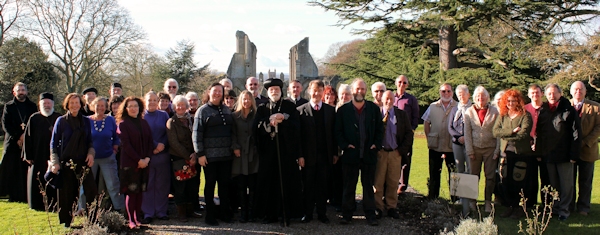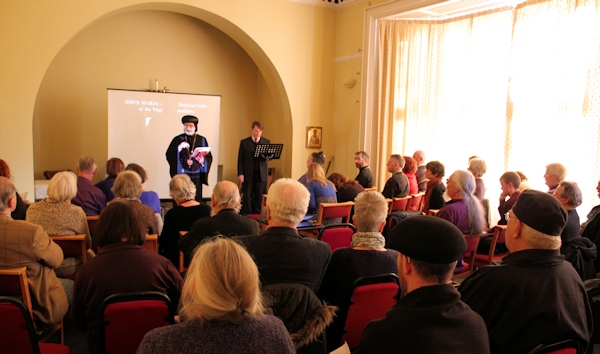Abba Seraphim welcomes statement by Patriarch John X of Antioch
Abba Seraphim has welcomed the recent comments by His Beatitude Patriarch John X of Antioch in his Encyclical Letter, which speaks of the need to work towards full sacramental unity between the two families of Orthodox Churches. “It is the most encouraging step in this long dialogue for several years and we must hope that other Patriarchs will respond with the same clarity and conviction as Patriarch John”, said Abba Seraphim. “The significant agreements made during the official dialogue between the Eastern & Oriental Orthodox Churches between 1985-1993 had seemed so full of promise but, sadly, over the past twenty years there has been little or no movement to build on these. In the past, the two Patriarchates of Antioch have been in the forefront of co-operation and practical implementation of the agreements reached. It is heartening to see that Patriarch John has made this a priority. At a time when the political situation in Syria is so dark and destructive, the reaching out in love between the two Orthodox families is a ray of light and hope.”
The section of Patriarch John’s extensive Encyclical which addresses this is given below:
“Towards a Full Sacramental Unity of the Christians:
We, as Antiochians, are aware of the painful wound inflicted on the body of Christ by the schism between the believers. This has led the Antiochian Church to participate actively for decades in every dialogue to remove the obstacles which block the way to restoring the unity of the Christian world. We will always be faithful to the policy of my predecessors. I insist on the importance of maintaining the absolute respect between the Churches ignoring any arrogance, anathematizing, and schismatization. I am deeply convinced that Orthodoxy; which is the basis of every interaction between us and other Churches, is a unifying factor not a divisive one. I am also convinced that adhering to it is the right way. With love and humility, we strengthen the common factors that bind us all together. There will undoubtedly be differences, not in essentials, and this a source of propitious diversity. This shall be considered a richness to us, and not a deviation of our adherence to Christ.
Therefore, we hope to accomplish all steps towards a full sacramental unity with our brethren in the Eastern non-Chalcedonian Churches, based on what we have agreed upon in Chambesy as a positive result of a long and extensive dialogue. If we realize this, we should be able to show that we have offered a living example of the credibility of our endeavors to achieve unity and to witness to our loyalty to the Lord. On this occasion, we also affirm that we will continue all dialogues now taking place between the different Eastern and Western Churches, seeking to show our unlimited readiness to show the face of the bride, that is the Church. In this respect, we should affirm the importance of the living witness which we as Christians should show by living the love we carry to the whole world in the name of Jesus Christ. We call for consultation among ourselves as Christian Churches, about the different issues raised by the modem world, emphasizing the issues that unite us and constitute our common denominators. These common denominators can be offered to the man of today as a consolation from the Lord.”
First British Orthodox Liturgy in Windsor
This is a warm invitation to two opportunities to worship with us in Windsor at our Orthodox Mission of St Andrew this week.
On Monday 11th March we are meeting to pray a service of Orthodox Evening Prayer in the English language. We begin our prayers at 6:30 pm at St Andrew’s Church of England, Mill Lane, Clewer, Windsor. Father Peter Farrington will lead the prayers from the Orthodox Daily Office of the Coptic Orthodox tradition in the English language. After the service of prayer there will be time for conversation and refreshments.
On Saturday 16th March, this coming Saturday, we are meeting to celebrate the Orthodox Liturgy in the English language for the first time at St Andrew’s, Mill Lane, Clewer, Windsor. Our morning of worship will begin at 9:30 am with the Raising of Incense, and the Liturgy itself will begin at 10:00 am. His Eminence Metropolitan Seraphim will celebrate the Liturgy assisted by Father Peter Farrington. There will be an opportunity for conversation and refreshments after the Liturgy.
You are most warmly welcome to attend either or both of these services. If you know of others who may be interested in participating in our Orthodox worship then do please pass this message on to them.
Seminar on Glastonbury Abbey – a great success

On 2 February Abba Seraphim chaired a well attended day seminar on “Glastonbury Abbey – Influence and Legacy” organised by the British Orthodox Church. It was held at the Abbey House in Glastonbury, across the lawns of which the impressive ruins of the mediaeval abbey stand. It was a crisp and sunny day and both the abbey and the town were bathed in sunlight. It was universally agreed that all four lectures were both informative and engaging and during the intervals in the proceedings, there was a relaxed and sociable interchange between lecturers and ‘seminarians’.
Dr. Cheryl Green opened proceedings by talking about the Glastonbury Abbey Excavation Archive Project, which has been analysing and reinterpreting the records of previous excavations made between 1908-1979. Her enthusiasm was matched by her helpful plans and matching slides as she explained some of the exciting discoveries and possibilities opened up by the project. Professor Michelle Brown, who engaged her audience with her brilliant knowledge and command of Anglo-Saxon manuscripts, showed how the wider cultural context impinged on Glastonbury Abbey and introduced documents known to have emanated or been kept at the Abbey before its Dissolution. Dr. Tim Hopkinson-Ball, whose previous studies on Glastonbury have dealt with its more recent history, showed a facile command of its mediaeval history and concentrated on the pre-eminence of the Marian cultus at Glastonbury. Dr. Adam Stout, who has previously dealt with Glastonbury’s little known 18th century history traced the development of the traditions concerning St. Joseph of Arimathea and how they were used as religious propaganda by both Catholic and Protestants. The last two speakers have both made notable contributions and original research to much neglected aspects of Glastonbury’s rich history.

It is hoped to publish some of the papers in the Glastonbury Review.
Among British Orthodox clergy present were Father Simon Smyth, Father Martin Lee (Sidmouth) and Deacon John Stuart (Exeter).
Following the conclusion of the seminar, Father Thomas Cook, a priest of the Western Rite Vicariate of the Russian Orthodox Church Outside of Russia, led Vespers at St. Margaret’s Church in Glastonbury.
Annual St. Felix Lecture falls victim to snow
The Annual Lecture & Service at St. Felix, Babingley, which traditionally conclude the Week of Prayer for Christian Unity, which was scheduled for Saturday, 19, January, has had to be cancelled as a result of the sudden cold spell, bringing with it heavy snow and serious disruption on the roads. Nicolas Crampton, founder of Eastern Christian Links, was due to speak on “Nicaea Revisited.” Abba Seraphim said that this was the first occasion in 12 years that the annual lecture had not been held. He stated that the lecture would be re-scheduled for a later date, but he would arrange this for a time when it would not be a hostage to the weather. “We have just installed new heaters at St Felix, so we could have managed with the low outside temperatures, but I am anxious not to put people at risk of accidents or being unable to return home safely and I do agree with the advice not to make unnecessary journeys if they can be avoided.” For the same reason, there will be no Sunday service at St. Felix on 20 January.
Glastonbury Abbey – Influence and Legacy
Glastonbury Abbey – Influence and Legacy
A seminar at
Abbey House, Chilkwell Street, Glastonbury
Saturday 2 February 2013, 10 am – 4.30 pm.
The last few years have been and exciting time for Glastonbury archaeology and history, with the rediscovery and reinterpretation of material from historic excavations, new surveys of the Abbey grounds and architectural remains, and the exploration of new directions in historical understanding. Here a group of distinguished scholars at the cutting edge of Glastonbury research present an overview of the Abbey’s role in national life from its shadowy beginnings to the dawn of the Romantic era.
Registration: £15, payable by cheque to ‘British Orthodox Church’
BOC Secretariat, 10 HeathwoodGardens, Charlton, London, SE7 8EP
Programme:
Welcome and Introduction: H.E. Abba Seraphim, Metropolitan of Glastonbury.
New archaeological perspectives from the Historic Excavations of Glastonbury Abbey
Dr. Cheryl Green
The Glastonbury Abbey Excavation Archive Project is analysing, reinterpreting and making available the entire unpublished archaeological archive from the excavations conducted between 1908 and 1979. The paper outlines the historic excavations and the scope of this project before introducing some of the new discoveries and re-evaluations in relation to the mid- to late Saxon period.
***
Coffee
***
Glastonbury‘s Role in Late Saxon England
Prof. Michelle Brown
Michelle P. Brown, Professor Emerita, University of London, and former Curator of Illuminated Manuscripts at the British Library will speak about Glastonbury Abbey in the Anglo-Saxon period and its contribution towards the material culture of the reform movement of the tenth century.
***
Sandwich Lunch
***
IESVS: MARIA: The Late Medieval Cultus of the Virgin at Glastonbury.
Dr. Tim Hopkinson Ball
Through the story of its foundation, a church explained its existence and proclaimed its sanctity, both to itself and to the wider world. This paper explores the Virgin’s centrality to Glastonbury’s self identity in the high Middle Ages, especially in relation to lived spirituality at the abbey and the monastery’s putative founder, St Joseph of Arimathea.
***
Afternoon Tea
***
After Arimathea
Dr. Adam Stout
Joseph of Arimathea, lionised as a proto-Protestant in Elizabethan England, was consequently put firmly in his place by Catholics keen to assert the primacy of Rome. Adam Stout looks at how the political and religious changes of the next century or so saw this potent figure re-adopted by the Catholic cause amid Jacobite claims to speak for the whole nation
Summary: Paul Ashdown.
